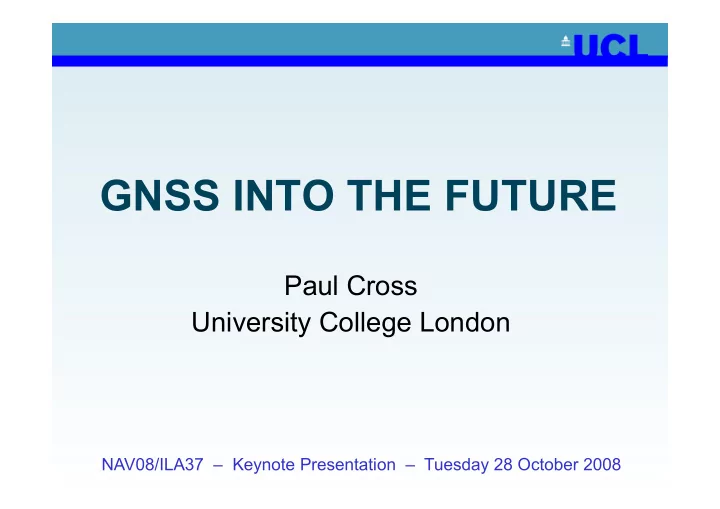

GNSS INTO THE FUTURE Paul Cross University College London NAV08/ILA37 – Keynote Presentation – Tuesday 28 October 2008
GNSS today • Thirty-one GPS satellites – L1 and L2 carriers modulated with codes and data message – Six are ‘modernised’ • Thirteen GLONASS satellites (+ three) – Frequency Division Multiple Access (FDMA) • Two Galileo test satellites • Four operational COMPASS satellites – three GEO, one MEO
GNSS today • Thirty-one GPS satellites – L1 and L2 carriers modulated with codes and data message – Six are ‘modernised’ Vast majority of • Thirteen GLONASS satellites (+ three) – Frequency Division Multiple Access (FDMA) current civilian • Two Galileo test satellites applications • Four operational COMPASS satellites – three GEO, one MEO
GNSS today (continued) • Free differential systems – Designed for marine use • Free space-based augmentation systems – Designed for aviation • World-wide commercial ‘augmentation’ systems – Supporting precision agriculture and ‘surveying’ • Commercial RTK systems – Supporting engineering surveying and mapping • Assisted-GPS – Mainly from mobile phone service providers • Scientific support services
That seems plenty! Why do we need more? • Fear of basing critical infrastructures on one GNSS • Civil GPS is primarily a single frequency system – Little interference protection and poor ionospheric modelling • Use of the second frequency is sub-optimal – Also it’s not in the ARNS band • Current GNSS signals do not have sufficient penetration • Not enough satellites for urban canyons • Quality of positioning is not sufficient – For some applications/usage ARNS – Aeronautical Radio Navigation System
What’s happening to GNSS? • GPS is being ‘modernised’ – Started in 2005 • GLONASS is being ‘refurbished’ – Will probably add CDMA (when?) • Galileo is fully funded and going ahead • Future Compass signal structure released • Many more SBASs announced
Features of some or all new GNSSs (1) • Separation of civilian and military(?) functions – Good and bad! • Built-in integrity (SoL) – protected frequencies • Increased power • Three (at least) ‘open service’ frequencies • Better clocks Interference Ionosphere • Better geometry Multipath Acquisition – at least for Europe Range precision Poor/good signals
Features of some or all new GNSSs (2) • More sophisticated and faster codes – Ten times C/A • New modulation schemes – BOC instead of BPSK • Pilot signals Interference – No data message Ionosphere Multipath • Forward error correction Acquisition Range precision – navigation message Poor/good signals
GNSS into the Future • 120(?) MEO satellites – Four interoperable and compatible systems • 20(?) GEO satellites • Extensive ground networks – With free and commercial services – Sensor network modelling • ‘Amazing’ new signal characteristics – Massive choice of ‘methodologies’ – Separate and combined solutions
What are the practical benefits? • Much greater satellite ‘visibility’ – More satellites, more power, longer codes, pilot signals – Fast acquisition (increases land-based kinematic use) • Much greater ranging accuracy – Longer and faster codes, pilot signals, less multipath/ion – More SVs will lead to better tropospheric modelling • More use of Precise Point Positioning – Especially through hierarchical positioning more • Better ‘regional modelling’ applications – Less dense regional networks – Sensor network approach to modelling • Potential for less power consumption in receivers
Why Positioning/Time? • Navigation and tracking – Traditional marine and aviation applications – Cars/buses/trucks – Trains/people/animals/assets …. • Location Based Services – Position + spatial information + comms • Communications needs time • Mapping • Scientific applications (e.g. tectonics/sea level) • etc GNSS is the ‘default’ positioning solution but …
Other technologies will be needed even more! • Inertial systems (especially MEMS) • Other dead-reckoning (e.g. odometers) • Radio navigation systems (e.g. eLORAN) • Mobile phone signals, SoOs • Pseudolites, UWB etc Others? • Track-aiding • Wi-Fi, RF tags • ‘Reverse’ photogrammetry with digital models Few ‘stand-alone’ solutions based on these technologies?
The messages! • Massive surge in positioning/time applications • GNSS will increasingly be the default solution • Because what GNSS can do is changing – For the better! • So is the way we will use it – Many more choices • But, and counter-intuitively, we will need other technologies more that ever
Recommend
More recommend